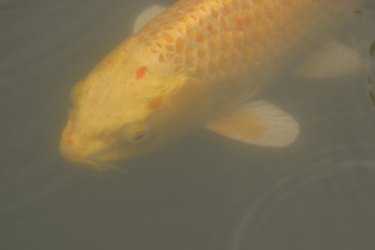
In even the best of cases, constructing a self-sustaining pond is a difficult task, particularly if you intend to stock the pond with fish. In order to accomplish this, it is important to keep two things in mind. First, there can't be too many large animals in the pond. Second, it will need to be quite large to provide enough environment for any aquatic creatures you decide to place into the pond. Remember that even a self-sustaining pond will require occasional care to maintain the right natural balance and water chemistry.
Step 1
Determine the placement of the pond in your yard. This can be done using a 25-foot garden hose to outline the edges of the pond. The hose provides you with the flexibility to shape your pond in any way you see fit. For a self-sustaining pond, a 25-foot circumference, combined with a depth of three feet gives you approximately 150 cubic feet of water. This is enough to support a large colony of small fish, several frogs, a small turtle and possibly a medium-sized koi fish. The small fish must be mosquito fish, which will feed on mosquito larvae laid on the surface of the water, as will the frogs. The turtle and koi will feed on the mosquito fish.
Video of the Day
Step 2
Dig out the pond to a depth of at least three feet. The first 12 inches below ground should be very nearly straight up and down to deter predators such as raccoons. Create a step-like shelf below this on which to place water plants, and then make the final 12 inches of depth vertical, as was the first 12 inches.
Step 3
Install the pond liner into the excavated hole, weighing the bottom down with sand or coarse river stones. Surround the top edge of the pond with large stones to weigh down the pond liner and hide its edges from view.
Step 4
Fill your pond with water, and then place a variety of water plants on the inner shelf of the pond, weighing their pots into place using large stones.
Step 5
Stock the pond with a large colony of mosquito fish to help control the potential increase in mosquito breeding in your yard. For a 150-cubic-foot pond, between 50 and 100 mosquito fish of 1-inch length are safe when using a biological filter.
Step 6
Install an out-of-pond biological filter for the pond. This step cannot be skipped. As the fish grow and eat, they produce more and more ammonia in the pond, which is poisonous to the fish. In a self-sustaining pond, this ammonia must be neutralized. This is done by providing a home for two types of bacteria, Nitrosomonas and Nitrospira. These bacteria, working together, break down ammonia and turn it into nitrates, which are absorbed and used by the pond plants. Without this biological filter, you would not be able to sustain a 500-gallon pond with fish, as it would be little more than a puddle.
Step 7
Introduce one or two 6-inch-long koi to the pond. Turtles and frogs will find their own way to the pond in time. Although the pond will be self-sustaining, it is important to test the water regularly, at least once per month using a pond test kit. This will ensure the health of the creatures inhabiting the pond.
Video of the Day